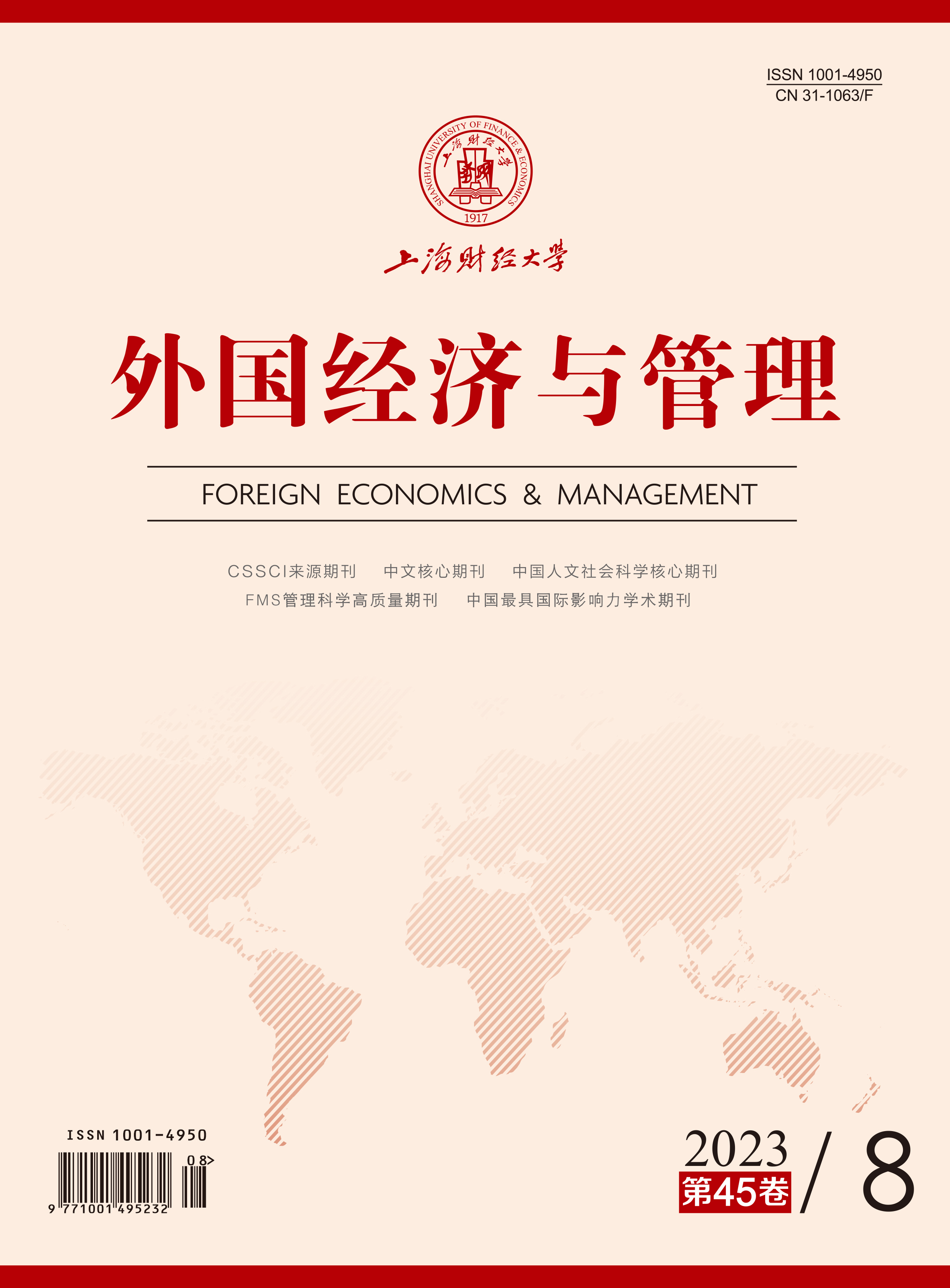面对日益复杂和不确定的外部环境,合理控制风险是企业实现稳健经营和高质量发展的关键。本文基于动态能力理论视角,构建“数字化进程—动态能力提升—企业风险”理论框架,并运用2010—2020年沪深A股上市公司数据实证检验了数字化对企业风险防御的综合影响效应。研究发现,数字化进程显著抑制了企业风险水平。这一结论经过多种稳健性检验后依然成立。进一步的机制检验表明,赋能价值共创、改善内部控制和增强信息透明度是数字化进程影响企业风险的三条主要渠道。本文还发现,上述效应在国有企业、多元化程度较低和规模较小的企业中表现得更明显。此外,数字化进程的风险抑制效应并未阻碍企业在研发投资领域的有效风险承担行为,而且在整体上对企业的短期经营绩效和长期市场反应都具有积极作用。本文深化了人们对企业风险水平决定因素的理解,也丰富了学界和业界对企业数字化转型经济后果的理论认知。
数字化进程与企业风险防御:基于动态能力理论视角
摘要
参考文献
1 卜君. 董秘变更与信息披露质量[J]. 会计研究, 2022, (1): 9-28. DOI:10.3969/j.issn.1003-2886.2022.01.003
2 陈德球, 胡晴. 数字经济时代下的公司治理研究: 范式创新与实践前沿[J]. 管理世界, 2022, 38(6): 213-239. DOI:10.3969/j.issn.1002-5502.2022.06.034
3 单宇, 许晖, 周连喜, 等. 数智赋能: 危机情境下组织韧性如何形成?——基于林清轩转危为机的探索性案例研究[J]. 管理世界, 2021, 37(3): 84-104. DOI:10.3969/j.issn.1002-5502.2021.03.007
5 焦豪, 杨季枫, 应瑛. 动态能力研究述评及开展中国情境化研究的建议[J]. 管理世界, 2021, 37(5): 191-210. DOI:10.3969/j.issn.1002-5502.2021.05.015
6 金智, 徐慧, 马永强. 儒家文化与公司风险承担[J]. 世界经济, 2017, 40(11): 170-192. DOI:10.19985/j.cnki.cassjwe.2017.11.009
7 李琳, 刘凤委, 卢文彬. 基于公司业绩波动性的股权制衡治理效应研究[J]. 管理世界, 2009, (5): 145-151. DOI:10.19744/j.cnki.11-1235/f.2009.05.016
8 李彬, 王凤彬, 秦宇. 动态能力如何影响组织操作常规?——一项双案例比较研究[J]. 管理世界, 2013, (8): 136-153. DOI:10.19744/j.cnki.11-1235/f.2013.08.014
9 李树文, 罗瑾琏, 胡文安. 从价值交易走向价值共创: 创新型企业的价值转型过程研究[J]. 管理世界, 2022, 38(3): 125-144. DOI:10.3969/j.issn.1002-5502.2022.03.008
10 李文贵, 余明桂. 所有权性质、市场化进程与企业风险承担[J]. 中国工业经济, 2012, (12): 115-127. DOI:10.19581/j.cnki.ciejournal.2012.12.010
11 刘启雷, 张媛, 雷雨嫣, 等. 数字化赋能企业创新的过程、逻辑及机制研究[J]. 科学学研究, 2022, 40(1): 150-159. DOI:10.3969/j.issn.1003-2053.2022.01.016
12 刘淑春, 闫津臣, 张思雪, 等. 企业管理数字化变革能提升投入产出效率吗[J]. 管理世界, 2021, 37(5): 170-190. DOI:10.3969/j.issn.1002-5502.2021.05.014
13 刘政, 姚雨秀, 张国胜, 等. 企业数字化、专用知识与组织授权[J]. 中国工业经济, 2020, (9): 156-174. DOI:10.3969/j.issn.1006-480X.2020.09.009
14 卢闯, 刘俊勇, 孙健, 等. 控股股东掏空动机与多元化的盈余波动效应[J]. 南开管理评论, 2011, 14(5): 68-73. DOI:10.3969/j.issn.1008-3448.2011.05.009
15 戚聿东, 蔡呈伟. 数字化对制造业企业绩效的多重影响及其机理研究[J]. 学习与探索, 2020, (7): 108-119. DOI:10.3969/j.issn.1002-462X.2020.07.013
17 戚聿东, 肖旭. 数字经济时代的企业管理变革[J]. 管理世界, 2020, 36(6): 135-152. DOI:10.19744/j.cnki.11-1235/f.2020.0091
18 权小锋, 吴世农. CEO权力强度、信息披露质量与公司业绩的波动性——基于深交所上市公司的实证研究[J]. 南开管理评论, 2010, 13(4): 142-153. DOI:10.3969/j.issn.1008-3448.2010.04.017
19 宋建波, 文雯, 王德宏. 海归高管能促进企业风险承担吗——来自中国A股上市公司的经验证据[J]. 财贸经济, 2017, 38(12): 111-126. DOI:10.3969/j.issn.1002-8102.2017.12.008
21 万文海, 刘龙均. 员工与用户内外协同对平台企业创新绩效的影响: 基于价值共创视角[J]. 南开管理评论, 2021, 24(2): 72-82. DOI:10.3969/j.issn.1008-3448.2021.02.008
25 吴非, 胡慧芷, 林慧妍, 等. 企业数字化转型与资本市场表现——来自股票流动性的经验证据[J]. 管理世界, 2021, b,37(7): 130-144. DOI:10.3969/j.issn.1002-5502.2021.07.010
26 肖华, 张国清. 内部控制质量、盈余持续性与公司价值[J]. 会计研究, 2013, (5): 73-80. DOI:10.3969/j.issn.1003-2886.2013.05.010
28 谢康, 吴瑶, 肖静华, 等. 组织变革中的战略风险控制——基于企业互联网转型的多案例研究[J]. 管理世界, 2016, (2): 133-148. DOI:10.19744/j.cnki.11-1235/f.2016.02.014
30 严楷, 杨筝, 赵向芳, 等. 银行管制放松、地区结构性竞争与企业风险承担[J]. 南开管理评论, 2019, 22(1): 124-138. DOI:10.3969/j.issn.1008-3448.2019.01.012
36 袁淳, 肖土盛, 耿春晓, 等. 数字化转型与企业分工: 专业化还是纵向一体化[J]. 中国工业经济, 2021, (9): 137-155. DOI:10.3969/j.issn.1006-480X.2021.09.008
39 赵宸宇. 数字化发展与服务化转型——来自制造业上市公司的经验证据[J]. 南开管理评论, 2021, 24(2): 149-161. DOI:10.3969/j.issn.1008-3448.2021.02.015
40 赵宸宇, 王文春, 李雪松. 数字化转型如何影响企业全要素生产率[J]. 财贸经济, 2021, 42(7): 114-129. DOI:10.3969/j.issn.1002-8102.2021.07.008
42 周茜, 许晓芳, 陆正飞. 去杠杆、究竟谁更积极与稳妥?[J]. 管理世界, 2020, 36(8): 127-148. DOI:10.3969/j.issn.1002-5502.2020.08.011
43 周泽将, 罗进辉, 李雪. 民营企业身份认同与风险承担水平[J]. 管理世界, 2019, 35(11): 193-208. DOI:10.3969/j.issn.1002-5502.2019.11.015
44 Acharya V V, Amihud Y, Litov L. Creditor rights and corporate risk-taking[J]. Journal of Financial Economics, 2011, 102(1): 150-166. DOI:10.1016/j.jfineco.2011.04.001
45 Beliaeva T, Ferasso M, Kraus S, et al. Dynamics of digital entrepreneurship and the innovation ecosystem: A multilevel perspective[J]. International Journal of Entrepreneurial Behavior & Research, 2019, 26(2): 266-284.
46 Bernile G, Bhagwat V, Yonker S. Board diversity, firm risk, and corporate policies[J]. Journal of Financial Economics, 2018, 127(3): 588-612. DOI:10.1016/j.jfineco.2017.12.009
47 Boubakri N, Cosset J C, Saffar W. The role of state and foreign owners in corporate risk-taking: Evidence from privatization[J]. Journal of Financial Economics, 2013, 108(3): 641-658. DOI:10.1016/j.jfineco.2012.12.007
48 Cheng M Y, Lin B X, Lu R, et al. Non-controlling large shareholders in emerging markets: Evidence from China[J]. Journal of Corporate Finance, 2020, 63: 101259. DOI:10.1016/j.jcorpfin.2017.09.010
49 Cheng S J. Board size and the variability of corporate performance[J]. Journal of Financial Economics, 2008, 87(1): 157-176. DOI:10.1016/j.jfineco.2006.10.006
50 Dichev I D, Tang V W. Earnings volatility and earnings predictability[J]. Journal of Accounting and Economics, 2009, 47(1-2): 160-181. DOI:10.1016/j.jacceco.2008.09.005
51 Ekata G E. The IT productivity paradox: Evidence from the Nigerian banking industry[J]. The Electronic Journal of Information Systems in Developing Countries, 2012, 51(1): 1-25.
52 Faccio M, Marchica M T, Mura R. Large shareholder diversification and corporate risk-taking[J]. The Review of Financial Studies, 2011, 24(11): 3601-3641. DOI:10.1093/rfs/hhr065
53 Faccio M, Marchica M T, Mura R. CEO gender, corporate risk-taking, and the efficiency of capital allocation[J]. Journal of Corporate Finance, 2016, 39: 193-209. DOI:10.1016/j.jcorpfin.2016.02.008
54 Fillis I, Wagner B. E-business development: An exploratory investigation of the small firm[J]. International Small Business Journal:Researching Entrepreneurship, 2005, 23(6): 604-634. DOI:10.1177/0266242605057655
55 Grönroos G. Conceptualising value co-creation: A journey to the 1970s and back to the future[J]. Journal of Marketing Management, 2012, 28(13-14): 1520-1534. DOI:10.1080/0267257X.2012.737357
56 Harris M, Kriebel C H, Raviv A. Asymmetric information, incentives and intrafirm resource allocation[J]. Management Science, 1982, 28(6): 604-620. DOI:10.1287/mnsc.28.6.604
57 Hutton A P, Marcus A J, Tehranian H. Opaque financial reports, R2, and crash risk[J]. Journal of Financial Economics, 2009, 94(1): 67-86. DOI:10.1016/j.jfineco.2008.10.003
58 John K, Litov L, Yeung B. Corporate governance and risk-taking[J]. The Journal of Finance, 2008, 63(4): 1679-1728. DOI:10.1111/j.1540-6261.2008.01372.x
59 Li H L, Wu Y, Cao D M, et al. Organizational mindfulness towards digital transformation as a prerequisite of information processing capability to achieve market agility[J]. Journal of Business Research, 2021, 122: 700-712. DOI:10.1016/j.jbusres.2019.10.036
60 Lim J H, Stratopoulos T C, Wirjanto T S. Path dependence of dynamic information technology capability: An empirical investigation[J]. Journal of Management Information Systems, 2011, 28(3): 45-84. DOI:10.2753/MIS0742-1222280302
61 Porfirío J A, Carrilho T, Felício J A, et al. Leadership characteristics and digital transformation[J]. Journal of Business Research, 2021, 124: 610-619. DOI:10.1016/j.jbusres.2020.10.058
62 Rialti R, Marzi G, Ciappei C, et al. Big data and dynamic capabilities: A bibliometric analysis and systematic literature review[J]. Management Decision, 2019, 57(8): 2052-2068. DOI:10.1108/MD-07-2018-0821
63 Teece D J. Explicating dynamic capabilities: The nature and microfoundations of (sustainable) enterprise performance[J]. Strategic Management Journal, 2007, 28(13): 1319-1350. DOI:10.1002/smj.640
64 Teece D J, Leih S. Uncertainty, innovation, and dynamic capabilities: An introduction[J]. California Management Review, 2016, 58(4): 5-12. DOI:10.1525/cmr.2016.58.4.5
65 Teece D J, Pisano G, Shuen A. Dynamic capabilities and strategic management[J]. Strategic Management Journal, 1997, 18(7): 509-533. DOI:10.1002/(SICI)1097-0266(199708)18:7<509::AID-SMJ882>3.0.CO;2-Z
66 Wen F H, Li C, Sha H, et al. How does economic policy uncertainty affect corporate risk-taking? Evidence from China[J]. Finance Research Letters, 2021, 41: 101840. DOI:10.1016/j.frl.2020.101840
67 Xie K, Wu Y, Xiao J H, et al. Value co-creation between firms and customers: The role of big data-based cooperative assets[J]. Information & Management, 2016, 53(8): 1034-1048.
引用本文
徐细雄, 段玲玲, 林翠梁, 等. 数字化进程与企业风险防御:基于动态能力理论视角[J]. 外国经济与管理, 2023, 45(8): 51-67.
导出参考文献,格式为:
下一篇:基于现象的研究:内涵、路径与方法
本期封面
相关论文





 8318
8318  8325
8325

